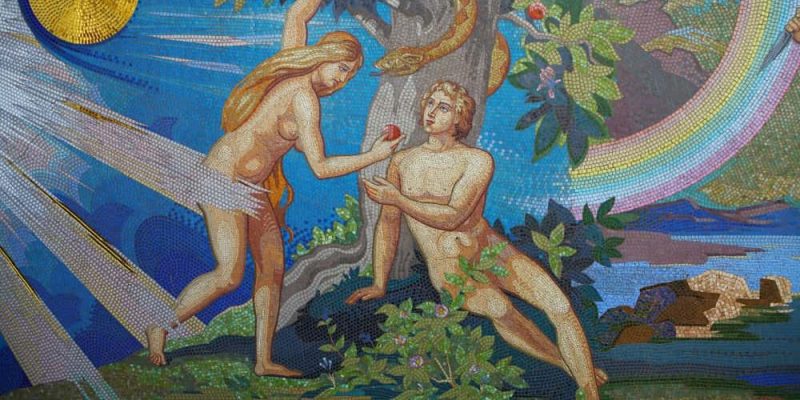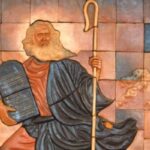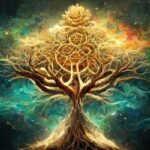We explain what the story of Adam and Eve is like, where it is told and what secular and religious interpretations have been made of it.

What is the story of Adam and Eve like?
According to Jewish, Christian and Islamic religious tradition, Adam and Eve were the first human beings, created by God. They are the protagonists of the biblical and Koranic story of the origin of humanity, as told in the first book of the Tanakh or Old Testament, called Genesis, that is, origin, and in the Koran.
The biblical account contains two accounts of the creation of Adam and Eve. The first (Genesis 1:26-31), possibly composed in the 6th or 5th centuries BC. C., narrates that God created human beings in his image and likeness on the sixth day of creation after having created everything else. He points out that he created them male and female, that he blessed them and told them to be fruitful, multiply and have authority over all living beings in the sea, sky and earth.
The second account (Genesis 2:4-25), older than the previous one, tells that God created Adam from the dust of the earth When there was still no vegetation, he breathed the breath of life through his nose and gave him the garden of Eden. There he placed it to cultivate it under a commandment: he could eat everything except the tree of the knowledge of good and evil, and if he did not respect this commandment he would die. Then God said: “It is not good for man to be alone” and created the animals, the birds and, from Adam's rib, the woman (Eve).
From then on, Adam and Eve lived in the Garden of Eden a paradisiacal place where they lived naked, because they did not feel shame, and could live in harmony with the rest of the animals, since they were God's favorite creatures.
In this place they were allowed almost everything and could feed on any tree available, except the one that God had forbidden them to test their faithfulness and obedience: the tree of the knowledge of good and evil. However, the story says that A snake tempted Eve and made her taste the forbidden fruit and also offer it to Adam who also ate it. Thus, both became aware that they were naked and covered themselves with some fig leaves.
So, God punished them, expelled them from the Garden of Eden and condemned them with mortality, work and pain. Adam and Eve had to learn to live on their own, and they had offspring. The three sons of Adam and Eve that are mentioned in the Bible are Cain, Abel and Seth, although it is also indicated that Adam had other sons and daughters.
According to the biblical account, upon expelling them from the Garden of Eden, God told Adam: “In the sweat of your face you will eat bread until you return to the earth, because from it you were taken; for dust you are and to dust you will return” (Genesis 3:19). To Eve he said: “I will greatly multiply your pains during pregnancies; In pain you will give birth to your children; and your desire will be for your husband, and he will rule over you” (Genesis 3:16).
Key points
- Adam and Eve were the first human beings, created by God. They inhabited the Garden of Eden, a paradise where they lived with other living beings.
- They were expelled from the Garden of Eden by God after tasting the fruit of the tree of the knowledge of good and evil, the only tree from which they could not feed. After this, God punished them to a life of pain and work.
- Adam and Eve star in the story of the origin of humanity shared by Judaism, Christianity and Islam.
- This myth was and is the reason for many artistic and literary interpretations and compositions.
Themes from the story of Adam and Eve
The story of Adam and Eve It is part of Genesis, one of the most important cosmogonic stories (about the origin of the world) of Antiquity. It is a mythical story that deals with the creation of humanity by God and is shared by the three Abrahamic religions: Judaism, Christianity and Islam.
It is also a story about the relationship between humanity and God that emphasizes themes such as obedience, disobedience, temptation, the knowledge of good and evil, and sin. In this sense, Adam and Eve are presented as those who committed the sin that caused their expulsion from the Garden of Eden which in Christian theology is understood as the “original sin” that caused the fall of human beings, their departure from paradise and their subsequent redemption with the arrival of Christ.
This means that the story of Adam and Eve was used in Jewish and Christian traditions as a mythical resource to explain the mortality of human beings and the laborious and sacrificial nature of their lives, as well as to draw attention to the consequences of actions. of individuals and – in the case of Christianity – to justify the idea of salvation through faith in Christ.
It is a story of guilt and punishment whose cultural and symbolic value in the Judeo-Christian tradition and in the West resided in the fact that A moral and religious discourse was built on it regarding topics such as obedience to God, human responsibilities, sexuality and the roles assigned to men and women.
Interpretations of the myth of Adam and Eve
The myth of Adam and Eve was the subject of many artistic and literary interpretations and compositions. For centuries it was a matter of debate among theologians and Christian scholars who discussed the correct way to interpret the allegories of the story. They often drew conclusions from them that shaped some aspects of society in the West.
For example, the fact that Eve offering the forbidden fruit to Adam was often read as proof of woman's sinful nature and his punishment was considered a justification for him occupying a subordinate place in society.
On the other hand, The different Christian churches assumed the obligation to free their faithful from the “original sin” committed by Adam and Eve since it was considered that this had been inherited by humanity but could be redeemed through faith in Christ. To achieve this, the rite or sacrament of baptism was applied (and continues to be applied), even among children, because although they are considered innocent of any personal sin, it is believed that they carry with them the original sin of the human being.
There were also many secular interpretations of the myth of Adam and Eve. For example, some considered the tree of the knowledge of good and evil as a metaphor for the knowledge, reason and inventiveness with which humans try to be, in some way, gods by changing the nature of the world to their will.
Others readings oriented towards psychoanalysis They emphasize the scene in which, after eating the forbidden fruit, Adam and Eve realized their nakedness and felt shame. These interpretations suggest that original sin refers to sexuality, and that the fruit and the serpent are metaphors for erotic desires. In this way, shame represents guilt for transgressing moral norms by discovering desire.
Although it is an ancient mythical tale, the story of Adam and Eve maintains its relevance today and was represented in an infinite number of paintings, literary stories, musical pieces and other works of art especially during the centuries of greatest Christian influence on Western art.
Curiosities about the story of Adam and Eve
Some curiosities about the story of Adam and Eve are:
- The forbidden fruit is not an apple. Generally, when we think of the fruit of the tree of the knowledge of good and evil that Eve tasted, we usually think of an apple. However, in the biblical text it is not said that it was an apple, but simply a fruit. It was from the Renaissance onwards that the forbidden fruit began to be represented as an apple. This could be because, in some cases, the Hebrew term peri (“fruit”) was translated by Latin malummedieval French pome and english apple.
- The serpent is not originally identified with the devil. In the biblical story, the snake is described as the most cunning animal that managed to tempt Eve to taste the forbidden fruit. Although in the Jewish tradition of the Second Temple era (from the 6th century BC), and especially in the Christian tradition, the serpent that tempted Eve was identified with Satan or the devil, in Genesis it is not mentioned this association. According to some researchers, the use of the figure of the snake in Genesis was due to the influence of other cultures in the Near East and Egypt, where this animal was sometimes considered a symbol of evil, the underworld or wisdom.
- The Garden of Eden is inspired by Mesopotamia. In Genesis it is said that the garden of Eden was located in the east of Eden and that a river flowed from it to water it. This river was divided into four branches: Pisón, Gijón, Tigris and Euphrates. Part of this description roughly agrees with the location of Mesopotamia, a territory bounded by the Tigris and Euphrates rivers (in modern-day Iraq). However, as it is a creation myth, the geography of Eden is more symbolic than physical. In any case, the Mesopotamian landscape seems to have been one of the main inspirations for imagining it.
- Adam could have had another wife besides Eve. Some theological interpretations consider that Adam had another wife: Lilit. One of these interpretations comes from the Talmud, a book with commentaries on Jewish law that points out that if it took Adam 130 years to beget his son Seth, as Genesis states (5:3), this was because he was separated from Eve for the anguish caused by her expulsion from Eden. Lilit was a mythical figure of Mesopotamian origin, adopted by Jewish tradition, and her name comes from Sumerian lilituwhich designated a demon that lived in the desert and could bring diseases. Another interpretation, proposed in a medieval book called The Ben Sira alphabetmaintains that Lilith was Adam's first wife, prior to Eve.
References
- The Editors of Encyclopaedia Britannica (2024). Adam and Eve (biblical figures). Encyclopedia Britannica. https://www.britannica.com/
- Gaines, J. H. (2024). Lilith. Seductress, heroine or murderer? Biblical Archeology Society. https://www.biblicalarchaeology.org/
- Graves, R and Patai, R. (2015). Hebrew myths. Alliance.
- Greenblatt, S. (2018). Rise and fall of Adam and Eve. Criticism.
- Liverani, M. (2005). Beyond the Bible. Ancient history of Israel. Criticism.
- Rogerson, J. (1993). The Bible. Land, history and culture of sacred texts. Folio.





